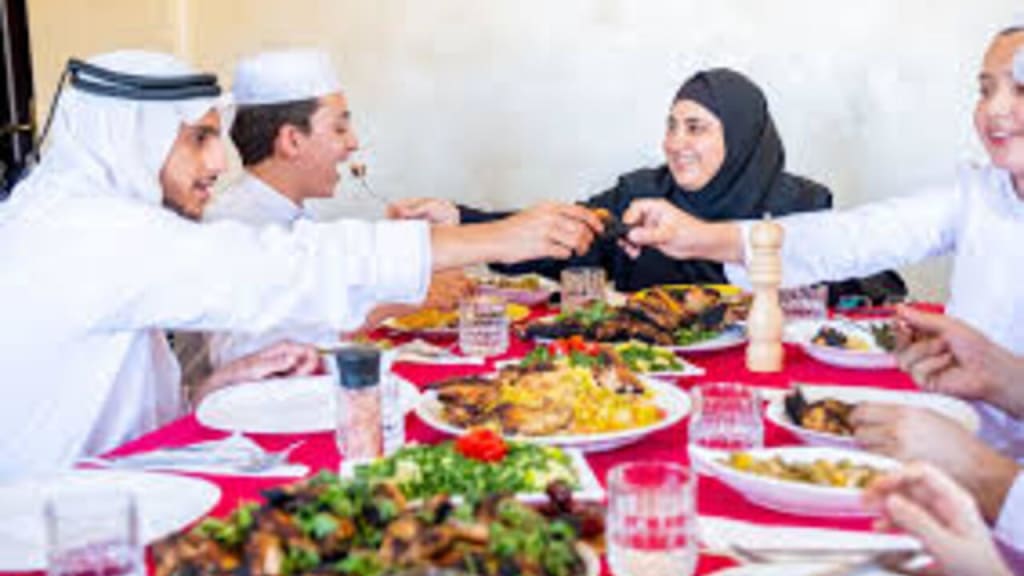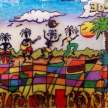Eid al-Fitr Feast: A Celebration of Faith and Unity in Muslim-Majority Countries
This article explores the rich traditions, culinary delights, and profound sense of unity that define the Eid al-Fitr feast in various Muslim-majority countries.

Introduction:
Eid al-Fitr, also known as the "Festival of Breaking the Fast," is one of the most significant religious holidays celebrated by Muslims worldwide. This joyous occasion marks the end of Ramadan, the Islamic holy month of fasting, prayer, and reflection. In Muslim-majority countries, Eid al-Fitr is a time of immense cultural and religious importance, characterized by communal prayers, festive meals, and acts of charity. This article explores the rich traditions, culinary delights, and profound sense of unity that define the Eid al-Fitr feast in various Muslim-majority countries.
The Significance of Eid al-Fitr
Eid al-Fitr is celebrated on the first day of Shawwal, the tenth month of the Islamic lunar calendar, immediately following the conclusion of Ramadan. The exact date of Eid al-Fitr varies each year, depending on the sighting of the new moon. The festival's significance lies in its commemoration of the end of Ramadan, a month of fasting from dawn until sunset, which is one of the Five Pillars of Islam.
The fast, or "sawm," during Ramadan is a time for Muslims to purify their souls, practice self-discipline, and empathize with those less fortunate. Eid al-Fitr, therefore, is not only a celebration of the physical completion of fasting but also a spiritual renewal and a reaffirmation of faith. It is a time to express gratitude to Allah for the strength to complete the fast and to seek forgiveness and blessings for the future.
Preparing for Eid al-Fitr
In the days leading up to Eid al-Fitr, Muslims engage in various preparations to ensure the festival is celebrated with due reverence and joy. Homes are cleaned and decorated, new clothes are purchased, and special foods are prepared. One of the essential pre-Eid rituals is the giving of "Zakat al-Fitr," a form of charity that ensures all Muslims can partake in the celebrations. This obligatory act of giving, typically in the form of food or money, is distributed to the needy before the Eid prayer, fostering a sense of community and mutual support.
The Morning of Eid: Prayers and Community Gatherings
Eid al-Fitr begins with a special prayer, known as "Salat al-Eid," which is performed in the congregation. These prayers are usually held in large mosques, open fields, or community centers to accommodate the significant number of worshippers. The Salat al-Eid consists of two units of prayer (rakats) and includes a sermon (khutbah) that emphasizes themes of gratitude, charity, and unity.
Dressed in their finest clothes, Muslims gather early in the morning for the Eid prayer, greeting each other with the phrase "Eid Mubarak," meaning "Blessed Eid." This communal act of worship reinforces the sense of unity and brotherhood among Muslims, transcending cultural and ethnic boundaries. The prayers are often followed by a sermon that reflects on the spiritual lessons of Ramadan and the significance of Eid al-Fitr.
The Feast: A Culinary Celebration
The centerpiece of Eid al-Fitr celebrations is the festive meal shared with family and friends. The variety and richness of the food reflect the diverse culinary traditions of the Muslim world. While specific dishes vary by region, certain themes and ingredients are common across many cultures.
1. Sweet Delicacies:
The breaking of the fast on Eid al-Fitr often begins with sweet treats, symbolizing the sweetness of the occasion. In many Arab countries, "ma'amoul" (date-filled cookies) and "baklava" (a layered pastry with nuts and honey) are popular. In South Asia, sweets like "sheer khurma" (a vermicelli pudding with dates and milk) and "gulab jamun" (deep-fried milk balls soaked in syrup) are enjoyed. In Turkey, "lokum" (Turkish delight) and "kadayif" (shredded pastry with nuts and syrup) are traditional favorites.
2. Savory Dishes:
Eid al-Fitr feasts also include an array of savory dishes that vary widely by region. In the Middle East, lamb or beef kebabs, "mansaf" (a Jordanian dish of lamb cooked in a yogurt sauce), and "maklouba" (a Palestinian rice dish with meat and vegetables) are commonly served. In South Asia, biryani (a fragrant rice dish with meat and spices), "nihari" (a slow-cooked stew), and "samosas" (fried pastry filled with meat or vegetables) are staples of the Eid table.
3. Bread and Rice:
Staple foods like bread and rice play a central role in Eid feasts. In North Africa, "khobz" (flatbread) and "couscous" (steamed semolina with meat and vegetables) are traditional. In Indonesia and Malaysia, "ketupat" (rice cakes wrapped in palm leaves) and "rendang" (a spicy beef stew) are enjoyed. In the Indian subcontinent, "naan" (leavened bread) and "pulao" (rice cooked with spices and meat) are common.
Cultural Variations: Eid Celebrations Around the Muslim World
Eid al-Fitr is celebrated with unique customs and traditions across Muslim-majority countries, reflecting the rich diversity of the Islamic world. Here are a few examples of how different regions observe this joyous occasion:
1. The Middle East:
In the Middle East, Eid al-Fitr is marked by large family gatherings and communal meals. In Saudi Arabia, after the Eid prayers, families visit each other's homes, exchange gifts, and enjoy traditional dishes like "kabsa" (a spiced rice dish with meat) and "mutabbaq" (stuffed savory pastries). In Egypt, "feseekh" (fermented fish) and "kahk" (Eid cookies) are popular.
2. South Asia:
In countries like Pakistan, India, and Bangladesh, Eid al-Fitr is celebrated with great enthusiasm. Preparations begin weeks in advance, with markets bustling with shoppers buying new clothes, jewelry, and gifts. On Eid day, the celebrations start with prayers, followed by visits to relatives and friends. Traditional dishes like "seviyan" (sweet vermicelli), "haleem" (a thick meat and lentil stew), and "biriyani" are enjoyed.
3. Southeast Asia:
In Indonesia and Malaysia, Eid al-Fitr, known locally as "Hari Raya Aidilfitri" or "Lebaran," is celebrated with a mix of local and Islamic traditions. The day begins with prayers and a ritual of asking for forgiveness from elders. The feast includes dishes like "ketupat," "lemang" (glutinous rice cooked in bamboo), and "satay" (grilled meat skewers). Visiting the graves of deceased relatives to pray and clean the graves is also a common practice.
4. Africa:
In African countries like Nigeria and Somalia, Eid al-Fitr is a major holiday. In Nigeria, the day begins with prayers, followed by festive meals featuring dishes like "jollof rice," "moin-moin" (steamed bean pudding), and "suya" (spicy grilled meat). In Somalia, traditional dishes like "halwa" (a sweet confection), "canjeero" (a type of flatbread), and "bariis" (a spiced rice dish) are enjoyed.
5. Central Asia:
In Central Asian countries such as Kazakhstan and Uzbekistan, Eid al-Fitr is celebrated with traditional customs and feasts. Families gather to prepare and share meals that include dishes like "plov" (a rice dish with meat and vegetables), "manti" (steamed dumplings), and "samsa" (meat-filled pastries). Visiting the elderly and sharing food with neighbors are important aspects of the celebrations.
Acts of Charity and Community Spirit
Eid al-Fitr is not only a time for feasting but also a time for giving. Acts of charity, known as "sadaqah," play a crucial role in the celebrations. Muslims are encouraged to give to those in need, ensuring that everyone in the community can partake in the festivities. This spirit of generosity and compassion is a cornerstone of Eid al-Fitr, reflecting the values of empathy and social responsibility emphasized during Ramadan.
In many Muslim-majority countries, community organizations and mosques organize charitable events, distributing food, clothing, and financial aid to the less fortunate. These acts of kindness strengthen communal bonds and promote a sense of solidarity and mutual support.
Modern Celebrations and Global Impact
With the globalization of cultures, the celebration of Eid al-Fitr has evolved, incorporating modern elements while preserving traditional values. In many urban areas, public festivals, parades, and cultural events are organized to mark the occasion. Social media and technology have also played a significant role, enabling Muslims around the world to connect, share their celebrations, and spread the message of Eid to a global audience.
In countries with significant Muslim populations, Eid al-Fitr is often recognized as a public holiday, allowing people of all faiths to join in the celebrations. This inclusivity fosters greater understanding and appreciation of Islamic culture and traditions.
Conclusion
Eid al-Fitr is a time of joy, reflection, and unity for Muslim communities around the world. The festive meals, communal prayers, and acts of charity that define this holiday embody the spirit of Ramadan and the values of faith, gratitude, and compassion. As families gather to celebrate the end of the holy month, they reaffirm their commitment to these values, creating a sense of togetherness and shared purpose that transcends cultural and geographical boundaries.
The Eid al-Fitr feast, with its rich culinary traditions and heartfelt customs, is a testament to the enduring strength and resilience of the Muslim community. It is a celebration of the human spirit, a reminder of the power of faith and unity, and an opportunity to spread joy and goodwill to all. As we celebrate Eid al-Fitr, let us embrace its message of hope and harmony, and strive to make the world a better place for everyone. Eid Mubarak
About the Creator
ED CLEFF
I have over a decade of experience in crafting compelling and diverse content. My portfolio spans multiple industries, including technology, healthcare, finance, and lifestyle, given me an added advantage in all my areas of specialization.
Enjoyed the story? Support the Creator.
Subscribe for free to receive all their stories in your feed. You could also pledge your support or give them a one-off tip, letting them know you appreciate their work.






Comments (2)
I live in Malaysia and this is a veryyyyy big celebration here
nice